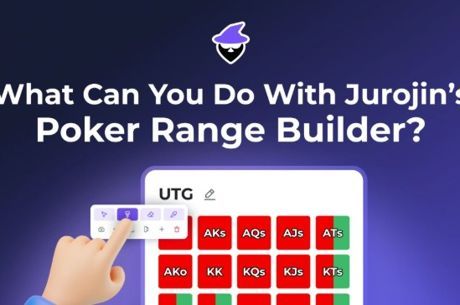"Ace" Speaks Live (1): Move-in Specialists

Recently, I was going through some old magazines, and saw a cover that carried the following text: "How to contend with one-trick pony all-in specialists." (Card Player, Vol. 16, No. 25, Dec. 5, 2003.) It referred to an article called "Take this entire stack and shove it!" by the late Poker Pundit Andy Glazer, the probably most talented and dedicated writer in the history of poker. The article discussed the recent trend in tournament poker for people to simply shove in their entire stacks early in the hand, rather than the way the old-school players used to do things: a much more balanced and subtle way of playing that included play on all streets rather than just before and on the flop. Still, there can be no doubt that this new breed of players has caused the "classic" players quite a few problems, especially those who could not adjust very well to the betting patterns of their opponents and their willingness to back marginal hands with their entire stacks, and more in general to the changed pace of most events - in part because of the presence of these young guns.
It needs to be said that if you ask around, you will find that the strategy of these young kids is not thought of as very sophisticated. Generally, the players who move in often are viewed at as people who have "one move only" and who "need to get lucky to be successful, because they certainly don't operate at a very high level". Actually, it's the same thing people have always claimed about my game, about the way I play in the big pot-limit Omaha live games. People have argued for years that a part of my winning strategy (keep a short stack, and bag my good hands to let aggressive players do the betting for me, get some callers in the middle and then check-raise all-in either before or on the flop) has nothing to do with 'real' poker, and that truly good players would never play that way. After all, people who play really well are supposed to try to cover everyone at the table in order to be able to break their opponents on one single hand, and also so that the size of their stack will enable them to outplay their opponents by bluffing and semi-bluffing them out of the pot. (Obviously, with a very small stack it is much harder to bluff or semi-bluff your opponents out of the pot, as they have much less decisions and also less meaningful decisions to make.) So, the argument of some of these critics of mine is that I'm just following a rather simple strategy, and that I'm basically a one-trick pony like the players mentioned above, someone who has only one move: the all-in move. (Of course, there are some major differences between tournaments and money games with regards to this move-in-early strategy. I will focus on money play today, and focus on tournaments in one of my upcoming articles.)
Anyway, while I would love to say that these critics of mine are horribly mistaken, and that this strategy of mine requires a lot more advanced thought processes than they seem to realize, the truth of the matter is that they are actually quite right. Whenever you are the very best player in your game, you would usually do best to keep a very large stack to try to take maximum advantage from the skill edge that you have over your opponents. However, if you think that this edge may not be that big actually (or even non-existent), like when you play against good and experienced players - whose only weakness may be that they seem to be overplaying their hands on occasion - then this strategy that I have used for years may be very helpful in getting premium results even when the opposition is strong. Because this small stack, move-in-early strategy does have some major advantages over "normal" play:
- You are maximizing your expectation on the hands that you win. Because you will be all-in once it is clear to your opponents cannot beat you (for instance, when you make top full or the nut flush while they were drawing to a lesser hand than that), they will have contributed much more money now than they would have with deeper money.
- When you've got very aggressive players on your immediate left, you may be able to build huge multiway pots either before or on the flop, and whenever you have the best hand or the best draw then you would often like to have as many opponents as possible once again, in order to maximize your expectation. In fact, if you make the proper decisions here, you should be able to build your initial (minimum) buy-in into three or even four times that amount on just one single hand. With a large stack, the best you can usually do is double up by breaking someone in a heads up pot.
- You risk very little in order to win rather big, while the large-stack approach carries a lot of risk: If your opponents outplay you on a big pot, or if you simply make one mistake, your entire stack might be gone.
- The small-stack approach tends to let the games last longer, because the weak player's entire stack won't be at risk all the time. If a good player with a large stack takes the entire stack of a weak player, then it is often "game over", as the weak player has no more money left, and thus for the other players there is no dead money left to fight for. Unless you are playing in a place that has multiple big-bet games for the stakes that you like to play, this is a not-to-be-underestimated factor to help the games last longer. Conversely, if a weak or average player by chance takes the entire stack of the strong player, then he may often decide to just hit-and-run, while in the situation where the money is not that deep, he might continue playing even after winning a decent-sized multiway pot.
- If you use my small-stack approach correctly, your aim should be to create multiway action early in the hand by check-raising whenever you've got the goods, and sometimes also when you are just trying to "gamble" with the boys. Either way, despite being a tight player, you do help in creating multiway action where the luck factor is relatively high. This means that you help giving the gambling type of players a fair chance of getting lucky once in a while, by winning a relatively big pot with a rather marginal hand. This is good for the long-term well being of the game, because if the weaker players would never win then the game would simply cease to be. But when the same weak player has a big stack and he faces a very strong player who has him covered, then this weak player is a very big dog to win even in the short run. This is especially true if the strong player has position on him which will usually be the case, because the strong player will simply move into a different seat to get position.
- By moving in early, you cannot get bluffed out because of scary boards, or bet off your hand on the flop or turn when the river would have given you a winner. This means that by moving in early, you will almost never fold the winning hand. In fact, it is probable that you can use the all-in to your advantage, because one of the remaining players may give you "protection" and bet someone off the hand that would have beaten you had there been no more betting.
Some final words
Now, all of this doesn't mean that a good player should thus start to play according to this approach quite the contrary, in fact. What it does mean is that the people who use this move-in-early strategy correctly should not be underestimated, or looked at with disdain. Quite often, these move-in specialists do have a reason for what they are doing, and especially when they are up against good and aggressive players, they often have an excellent counter-strategy to negate their experienced opponents' superior skills. By using "my" approach, youcan put them to the test early, and you will avoid getting outplayed on the later streets. Of course, it is a rather simplistic way to play poker – but just because it is doesn't mean it is also an unsuccessful or unprofitable way to play.





